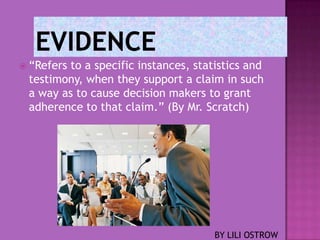
1 st presentation lili speech 104
- 1. “Refers to a specific instances, statistics and testimony, when they support a claim in such a way as to cause decision makers to grant adherence to that claim.” (By Mr. Scratch) BY LILI OSTROW
- 2. Evidence is a proof, it used as a key to achieve your audience trust, and devotion to your arguments. Evidence establishes the amount of accuracy your argument have. In order to convince a person, you need evidence. Evidence is a good base to our arguments.
- 3. Evidenceneeds to be carefully chosen to serve the needs of the claim and to affect the target audience.
- 4. Anargument is designed to convince a resistant audience to accept a claim through the presentation of evidence for the claim the advocate is presenting. Evidence by itself will not do the job.
- 5. An arguer may have a destination point and a road map for getting there, but unless the signs along the way are clearly marked and in the logical order, the traveler will become lost. Maps after all must be read so that the directions make sense.
- 6. The quality of the argumentation depends on the quantity of evidence. One source compared to various sources. Too much evidence may leave the audience overwhelmed and without focal point. Evidence and reasoning in support of the claim should reach “critical mass”- evidence which, when stacked up and linked to the advocates claims, achieves a level which makes acceptance more likely.
- 7. Itis ultimately depended by the demands of his or her target audience. There are three types of audience that an advocate must deal with: A FRIENDLY AUDIENCE- 1. already supports an advocate’s position on a claim. 2. very little additional evidence is needed as support.
- 8. B. A NEUTRAL AUDIENCE-audience who does not have any point of view to the advocate idea. Audience waiting to see what type of support can be provided in order to convince them to be pro or against the claim. This type of audience is also called “fence sitting”. The quality of the evidence used is important to this type of audience. C. A HOSTILE AUDIENCE-is audience who is against to your point of view. A great deal of evidence is needed in order to convince them.
- 9. 1. Precedent evidence: A. Legal precedent- it is one of the most powerful and most difficult types of evidence to challenge. Once a principle of law has been established by a lawmaking body, it is very hard to change it. B. Personal precedent- happens as a result of watching the personal actions of others in order to understand the expectations for future behaviors. New workers on a job watch to see what older workers do in terms of breaks and lunch time in order that their actions may be consistent.
- 10. C. Statistical evidence-consists primarily of polls, surveys and experimental results from the survey institute. * Statistics are not more reliable than other forms of evidence they are affected by human prejudice, bias and error.
- 11. There are 3 forms of testimonial evidence:
- 12. 4. Hearsay evidence- known as rumor or gossip evidence. It is an assertion that is transferred from person to person. Individual can never know if rumor is true or not. Such use of "hearsay evidence" in court is generally not allowed. 5. Common knowledge evidence- is based on an argument that its knowledge is known to everyone. This is the best way of supporting an argument, because mostly everyone is going to accept it without any assertions.
- 13. In order to tell how an individual know about a certain subject. The person need to indicate where the information came from? Who heard it, saw it, and where he saw it happens.
- 14. END